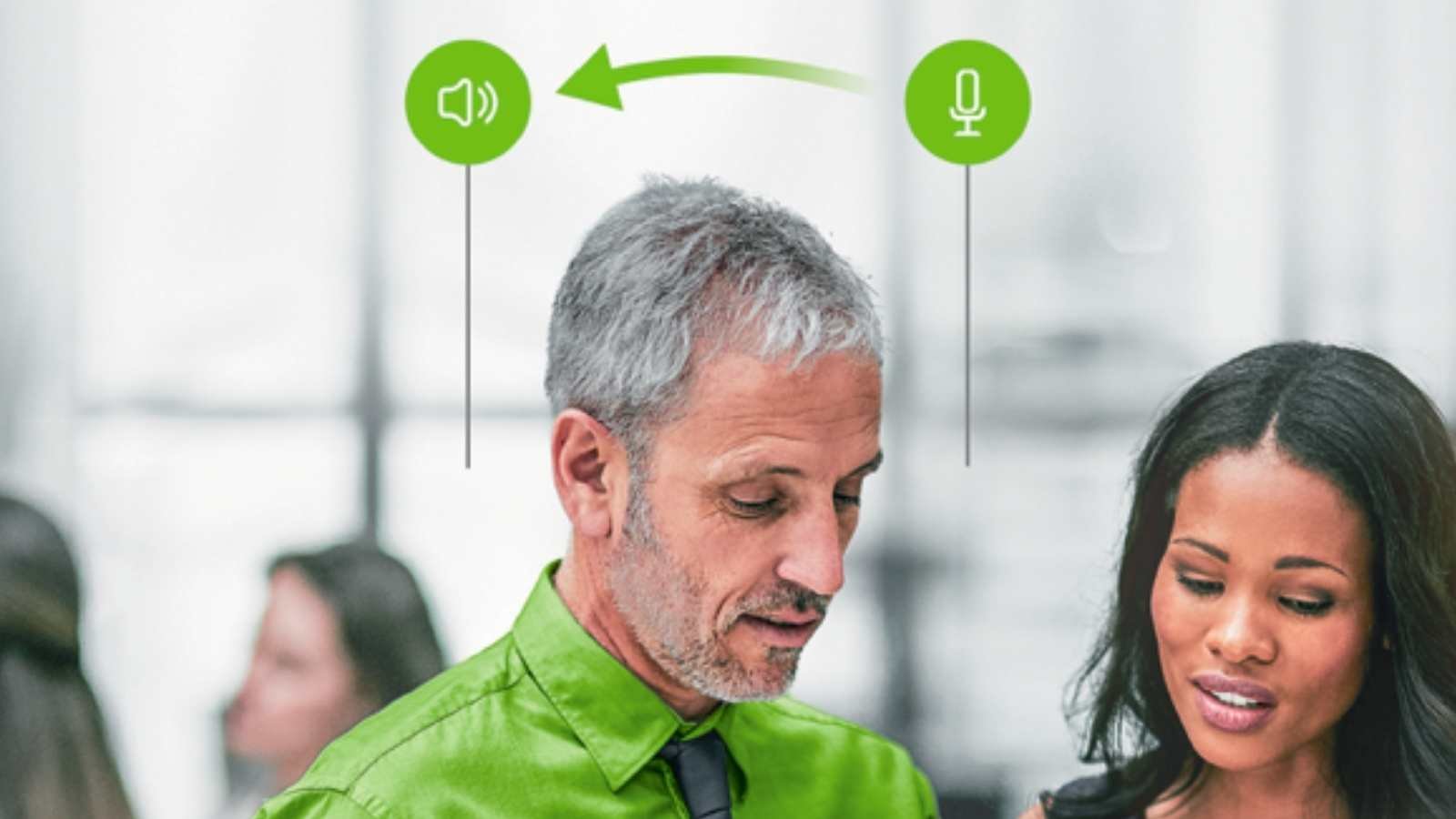Key Takeaways:
- If you struggle to hear someone seated towards your poorer ear, a CROS device is an option that can help.
- CROS hearing aids work by sending sound from the poorer ear over to the better ear, so that you can more comfortably communicate in the car, at a dinner party, or in other situations that can be otherwise challenging.
- CROS devices are available through prescription care in a local audiology cinic.

CROS Technology for Those With Single-Sided Hearing Loss
Do you have good hearing in one ear and a lot of hearing difficulty in the other ear? Certain types of hearing devices are specifically designed to help those with single-sided deafness (SSD).
Read on to learn more about CROS hearing aids.
Prefer to watch?
Our full breakdown of single-sided hearing tech below. 👇
Background
Not everyone has hearing loss in both ears. Sometimes hearing loss affects only one ear.
Several different etiologies can cause a sudden hearing loss, for example, a benign tumor on the hearing nerve (vestibular schwannoma), viral infection, or Meniere's disease.
Single-Sided Hearing Loss Challenges
Single-sided deafness (SSD) comes with particular specific challenges. One ear hears normally, while the other ear has significant hearing loss. In quiet situations, understanding isn't a problem. However, a number of other situations can make it difficult to understand. For example, when someone speaks to your bad ear and there is noise coming to the good ear.
The car is one place where single sided hearing loss is noticeable. When you're the driver, it will be hard to converse with the passenger if your good ear is facing the road noise by the window. The same is true in social situations when the speaker is located on the bad-ear side.
This can be even more challenging for those with some hearing loss in the good ear.
Adding in any level of background noise can really change how much of the conversation comes through, understandably.
Additionally, when the hearing loss in the worse ear is significant enough, speech understanding is often quite low with traditional hearing aids. In this situation, putting a conventional hearing aid on an ear with substantial hearing loss and a lack of speech clarity will likely not be helpful.
CROS Hearing Aid Technology
In these cases, a CROS hearing aid system is recommended. CROS devices route the sound from one side of the head to the good ear. Let's take a closer look at a CROS hearing aid and how it works.

How CROS Hearing Aids Work
CROS is an acronym that stands for 'contralateral routing of signal,' and a CROS hearing aid system is made up of two devices: 1) traditional hearing aid and 2) a microphone. On the outside, it looks like two hearing aids. The device with the microphone is worn on the ear in the same way as a traditional hearing aid.
A CROS hearing aid is a device with a microphone that picks up sound coming to the 'bad ear' and sends it to a hearing aid on the good ear.
Think of it this way: the bad ear cannot understand speech, so instead, it gets sent to the better ear that can easily understand it. The microphone picks up when someone speaks towards the bad ear, making it much easier to understand.
Note: in research contexts CROS is sometimes also referred to as 'contralateral routing of off-side signal'

Who will benefit from a CROS?
If you have SSD, a CROS can be very helpful in situations where your conversation partner is positioned towards your bad ear. It will do a good job of sending the sound over to your better ear in this scenario. However, in situations where the microphone is picking up noise and sending it to the good ear, that will likely not be useful and can even make it harder to understand. Therefore, a CROS hearing system will work best for those with SSD in specific situations.
Those with SSD can also evaluate surgical interventions, such as cochlear implantation or bone-anchored hearing aids. However, a non-surgical trial of a CROS option is advisable first for two reasons. 1) Insurance will often advise or require a hearing aid trial before proceeding with surgery. 2) Additionally, some people find sufficient benefit from hearing aids and choose not to pursue surgical options.
How Are BiCROS Hearing Aids Different?
A BiCROS device is just another configuration of a CROS that gives the better ear some added volume. This device is programmed for someone with some hearing loss in their better ear while still sending all of the sounds from the poorer ear over to the better ear. A person with mild or greater hearing loss in their better ear will benefit from a volume boost based on their hearing prescription, in addition to having the sound from the poorer ear sent over to the better ear.
Most leading CROS devices have a built-in option for added amplification on the good ear. Your audiologist will administer a hearing test and program your CROS device to match your specific hearing loss.
Best CROS and BiCROS Hearing Aids
Several top hearing aid manufacturers make CROS devices that are specifically designed to send audio from one side of your head to your better hearing ear. The brands below are our favorites.

Phonak CROS - Best Bluetooth Connection

Phonak is one of the top hearing aid manufacturers and a leader in CROS technology as well. Phonak makes a CROS hearing aid with a variety of useful features. The CROS device and compatible hearing aid works with the Phonak Lumity platform and come in several different levels of technology. This device comes in both rechargeable and size 13 battery options.
The Phonak Audeo Lumity hearing aid is compatible with Phonak CROS in rechargeable and battery-powered options. This device also works with the myPhonak app and is compatible with iPhone as well as Android.
Pros
- For Android users, Phonak is a great option. Bluetooth Classic allows for more options for device connectivity.
- The Phonak rechargeable case has a compartment for a drying capsule and works well for active individuals.
Cons
- Notifications cannot be disabled when Bluetooth is connected to the phone.
- If dexterity is a concern, it can be difficult to remove the hearing aids from the charger.
- For the battery option, size 13 will be a larger size than 312.
Find Care

Oticon CROS - AI-Powered Background Noise Reduction

The Oticon CROS PX is available to work together with the Oticon More and will also have forwards and backward compatibility with other Oticon hearing aid models. The Oticon CROS uses NFMi technology to communicate between transmitter and receiver. The CROS is available in rechargeable and battery (size 312) options.
The Oticon ON app works well with iPhone as well as some Android models.
Pros
- For iPhone users, Oticon is a great option.
- The Oticon rechargeable case is easy to work with for all levels of dexterity.
- The rechargeable battery is able to be replaced in the office and doesn't need to be sent in if the battery needs to be replaced.
- The battery option uses a size 312, which means a device with a smaller profile.
- The app offers a "Find My Hearing Aid" feature in the app.
Cons
- The simplicity of the app does not allow for making a lot of adjustments or changes.
- Oticon uses the ASHA protocol to connect to a phone, which can make connectivity less stable.
Find Care

Signia CROS X - Best Battery Life

The Signia CROS X works together with the Signia Pure Charge&Go hearing aid. The CROS is available in both rechargeable and battery options (size 312). The Signia app works with both iPhone and Android.
Pros
- Convenient charging case.
- The 'mask mode' on the app can be very useful to ease understanding.
- Additional features on the app can be adjusted, such as microphone directionality.
Cons
- Lower levels of technology will need to use the app in order to adjust the volume or other settings (rather than the button).
Find Care
Final Thoughts
For those with SSD, a CROS hearing aid can be a great option to help in situations when the speaker is located on the poorer ear side. Use your hearing aid trial period to your advantage to find what works best for your situation.
The products mentioned in this guide are some of the best available and will offer your audiologist lots of customizations to meet your specific needs. We hope this guide has been helpful. If you have more specific questions we'd love to hear from you at [email protected].





